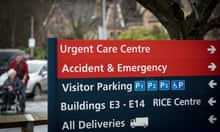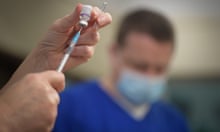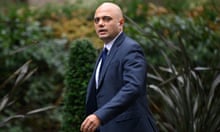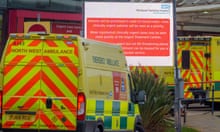I am often surprised when I speak to non-medical friends. They are generally less interested in what is going on, but when they do ask they are surprised to hear that we are still under so much pressure.
There is a general perception that this is all under control now.
So what is working in a hospital at the moment actually like? Take our emergency department. Currently, we regularly see 50% more patients per day in A&E than the maximum it was ever designed for.
There is often a wait to secure even a cubicle to bring a patient in for examination. Sometimes I have to send a colleague to fetch a patient while I wait in some inappropriate location – on one occasion an equipment store – just to reserve somewhere with sufficient privacy before someone else takes it.
Ambulances queue outside the door with waits of hours just to unload their patient and get back on the road; a criminal waste of their time. On top of this, once our staff vacancies are accounted for – 20-30% even for the caseload for which we are designed and budgeted – we are often functioning with staff ratios less than 50% of what they should be.
Our “performance” – the number of patients seen within four hours, and leaving the department within 12 hours – has nosedived, something for which we will be financially penalised later, although it’s hardly our fault.
The problems do not stop once a patient has been assessed. There are precious few beds available on our wards. It is worth pausing to remember that the optimum bed occupancy to be efficient is 85%. To my knowledge, our hospital has never run as low as this ever since I have been here. We usually run around 95% even in summer months, and often over 100% as patients discharged in the morning are replaced in the afternoon. Even a small increase in demand is therefore critical.
We have had to declare several “internal incidents” in the past two months due to the bed crisis. This happens when the situation becomes so bad that patient safety is directly threatened; often when there are maybe 30 patients in A&E – all assessed and needing admission to hospital –but no onward beds to place them in. The whole system clogs up and becomes dangerously unsafe. Other than try to discharge patients, there is not a lot we can do in this situation.
We are also seeing the return of other respiratory viruses that have begun circulating again as social distancing and mask wearing relax. So I am interested to see that the trigger for reintroducing restrictions is “unsustainable pressure on the NHS”, with “pressure” conveniently undefined. How much pressure do you want?
We are still not into winter and this is already unsustainable.
Staff are quitting and burnout and low morale are rife. GPs are under similar pressure but have the added injustice of an over-reaching health secretary who has needlessly picked a fight by not respecting their autonomy and publicly denigrating them. Maternity, social care, community services, mental health services – all are struggling. We really are at breaking point.
My real worry is that I see no sign that those leading us have learned from any of our earlier mistakes. The Health and Social Care committee’s recent report described our initial response as one of the UK’s worst ever public heath failures. Some of the key failures were identified as, among others: a failure to act decisively in the face of the initial emergency; a belief in British exceptionalism resulting in a failure to learn lessons from other countries ahead of us in the curve (Asia, Italy); a failure of test and trace; failure to anticipate the second wave, or to act decisively to prevent it; an abject failure to protect our care homes. These are strongly worded, unequivocal conclusions.
Personally, I don’t think this report went far enough. I would add to this list the failure to use the private sector properly, and the waste of enormous amounts of resource on the Nightingale hospitals. Private hospitals, and their workforce, should have been thrown open to help in any way possible, and mandated to if they did not agree; instead, they largely stood by and are now profiting directly from the long NHS waiting lists as patients seek help elsewhere.
We had a wealth of advantages that should have placed us at the forefront of how to respond to a crisis like this. Indeed, we had been highly rated in our pandemic preparedness. We are world leaders in medical research. We were one of the earliest to develop testing, but then failed abjectly to increase capacity in time.
We have a centralised and standardised healthcare system that can rapidly assume a command-and-control structure that makes it responsive and nimble when needed to be.
But this requires strong and decisive leadership, and we were failed. The groupthink that pervaded the government at the time, whether they were following the science or not, implies a failure to construct a leadership environment where people feel empowered to challenge and think independently.
For me personally, however, it is the failure of our hospitals to protect care homes that weighs most heavily on my mind. Deep down, I suspected at the time that sending patients out without retesting, a few days after their diagnosis, into ill-prepared care homes was unsafe and that many must have still been infectious.
Some of our local homes lost more than a quarter of their residents.
Why didn’t I, or others, speak out? Our minds were elsewhere, focused on the incoming tide, and this is what we were being told to do. And we didn’t have enough tests even for our staff.
But I wish I had. It might not have been heard, but at least I’d have said it. Thank goodness we are more careful now.
And yet, of all the failures listed above, this is the only one that we have gone some way to rectifying. And I see no evidence at all of any such self-reflection in those at the top. We continue to dither in the face of rising cases and pressure, despite the clear picture from other European countries that have retained some restrictions and now have fewer cases. We have given up on contact tracing.
We still seem to think we can vaccinate our way out of this, yet even that process is foundering and takes no account of the non-Covid infections to which our immunity has fallen.
Our leaders can’t even set an example in government (I hear it’s “not comfortable sitting for hours in a mask”; so come on a 12-hour shift with one of us in that case). “The science” seems to be being sidelined now, and nothing is changing.
We need a formal inquiry, and urgently. This crisis is still going on and we need to learn lessons to inform our ongoing response. Not to call one is shameful.
In the meantime, I watch and wait as we repeat the same mistakes over and over again.
The writer is an NHS respiratory consultant who works across a number of hospitals









